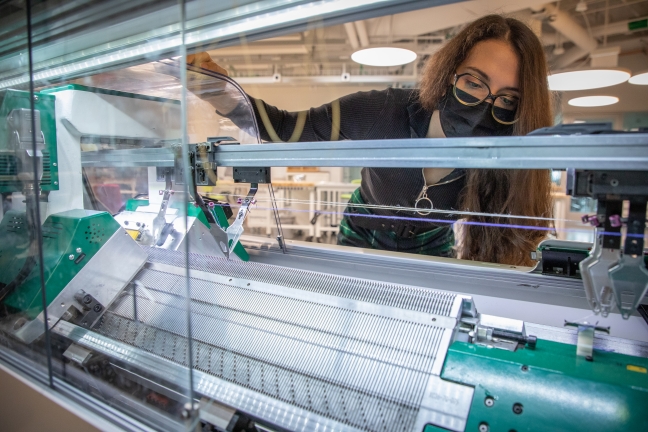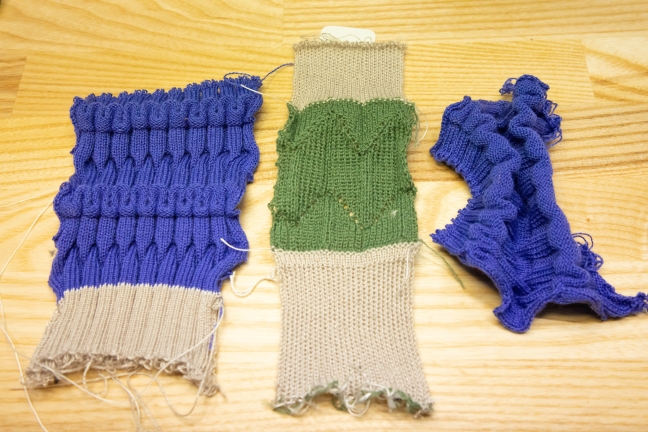Can you introduce yourself?
My name is Vanessa Sanchez. I am a Ph.D. student. And I'm in the material science and mechanical engineering program.
Can you tell me about your choice of research?
I always liked making things and creating things. My mom was a quilter. I also like taking things apart. And my mom was maybe like, maybe you should start putting things together, instead of ripping everything apart in our house. So she got me a sewing machine when I was about 8 years old.
I did start out in fashion school and went to FIT [Fashion Institute of Technology]. But around that time, I realized I kept on noticing problems including, like having rain jackets that would seep in water at the seams, or having a coat where I couldn't move my arms in. And I was more interested in figuring out how to solve these problems.
So I decided to study fiber science. And I got deeper and deeper into the science and realized I love doing research. And at the same time, those problems were small inconveniences for me, I realized were really big for problems for people with disabilities as well. So I decided to pursue a Ph.D. in material science and mechanical engineering, working in robotics where I can make textile fabrics that can be used in assistive garments, as well as maybe change fashion a lot.
Sanchez programs a machine to create knit textiles and studies the resulting material.
Knitting samples made through a machine. Sanchez notes that it's very stretchable in one direction (warp), and very stiff in the other direction (weft). Knit materials are typically stretchy all-around, but these ones are created by tuning the bending stiffness of two separate materials and putting them together. The original mono-filament of the yarn is stiff, but the structured knit created a more stretchy material. (Textile credit: Kausalya Mahadevan)
What are you currently focusing on?
My research focus right now is on robotic textiles. And what that means are fabrics that have both a sensing and an actual nation component. Sensors let us know the state of the fabric, where it is, what position, its environment. If it's on a body, it can let us know some information about the person, depending on what kind of sensor we have. Then on the other hand, we have actuators. And these are the movers. So that means either the fabric changes shape, or it applies a light force to the body.
What are some of the applications for this work?
The applications for my work right now, shorter term, are definitely medical devices - assistive devices that can be used to help people with disabilities. One project that I worked on was called STATs, Smart Thermally Actuating Textiles. And these were arrays of robotic textiles, modules we call them. And they could be used in the cushion of a wheelchair. So if you aren't seated or if you have the ability to shift around, then you're making minor adjustments all throughout the day. But people that don't have that ability, like people with spinal cord injury, can't make those small adjustments. So when they're seated throughout the day, they might start developing pressure points. And this can lead to things like pressure sores. Having these textile modules that pressurize and depressurize, that can inflate, then you can distribute the pressure throughout the day. You can kind of change where the pressure is.
Longer term, I probably have pie in the sky visions for robotic textiles. One thing that I wonder, in the future of garments that can change shape, that can maybe apply forces, could you have clothing that you kind of download? Like “I want it to look this way,” or “I want it to puff out.” What the clothing would end up being based on your needs. And even going back to the assistive devices…maybe one day, you're like, “Hey, I injured myself.” Could the clothing start applying these forces or helping you? Only if you need it. You can just download an app to your garment, but that is very pie in the sky.
Is there anything else you want to say about your own aspirations?
My long-term goal is to be a professor and run a research group. I really love doing research. I love ideating with other people…it's so exciting to be in a place where I can chat with other scientists. Everyone brings something different to the table based on their experience, based on their background, and that we can get together and create cool, new ideas.

